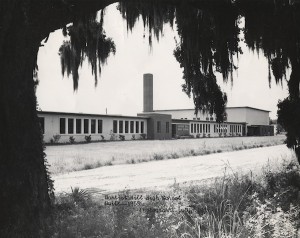Project Showcase: South Carolina’s Equalization Schools
23 November 2012 – editors
digital media, preservation, projects, social justice, public engagement, memory, scholarship, education, human rights
In the 1950s, South Carolina embarked on a massive statewide building spree in an effort to provide “separate but equal” schools for its African American and white students. Hundreds of new elementary and high schools in the Modern style sprung up across the state. Over time, the history of this building program and the schools it produced became only a footnote in history. I was lucky to “discover” this history during my master’s in public history program at the University of South Carolina. Early research into what I call “equalization schools” led to a survey of existing schools in Charleston County and a master’s thesis on the school construction program.
I decided to use digital media to publish my thesis and a few years after graduation, I began a website to spread the history of the equalization school program and to serve as an archive of all the known equalization schools in South Carolina. The project took off. People sent me information about the schools they attended, or equalization schools in their communities. Newspapers wrote stories about the program. A local high school history teacher found the site and began crossing the state to photograph equalization schools. A student at Furman University used the information on the site to create a “historical episode” for The History Engine.
Using the input of the visitors to the site and local volunteers, we have recorded over 130 equalization schools for the South Carolina Statewide Survey of Historic Resources. The Charleston County School District is planning a local exhibit on equalization schools to open in the near future. Find us on Flickr, too!
~ Rebekah Dobrasko





What a fascinating project! Your research hints at a darker side of desegregation– the creation of private “segregation academies” and the relative decline of the public school system in areas predominantly inhabited by minorities. Is this something that the exhibit about the equalization schools will discuss?
Hi Adina! Sorry about the delayed response! We haven’t yet developed the text for the exhibit, but I am not sure how much we will go into the segregation academies story. You are right, the results of desegregation are messy and “dark,” and while I mention that a bit on my website, I will have to see how well that would translate to the exhibit.
It is not that there was a darker side in segregation in South Carolina; segregation was the law of the land. Hence: Plessy vs. Ferguson 1896. I am a graduate of one of the equalization schools and also astonished when in a historical context, the schools integrated only a few years ago in 1970. Thank God South Carolina has begun to include information about these schools in its social studies curriculum. I made PowerPoint starting the Dred Scott’s U.S. Supreme decision of 1857, 14th Amendment U.S. Constitution 1868, with emphasis on its the equal protection clause, to Plessy vs. Ferguson 1896 (ruling segregation was legal) to the Briggs vs., Elliott case leading to the Brown vs., Board of Education 1954. My presentation included pictures the old wooden building that 50% of the graduates of the school attend in their earlier years in at one grade. This is an important path to look at because the 14th amendment essentially overturned the Dred Scott’s decision in 1857 by defining citizenship, and Plessy vs. Ferguson ignored the equal protection clause in 14th Amendment, and finally Brown vs. Board of Education 1954 overturned its 1896 ruling. I was in 5th graded when Chestnut Consolidated open it doors. I often encourage people to read these documents for a better understanding of what happened a few years ago in the state and country, especially the south. I also encourage people to read “The Warmth of Other Suns” by Isabel Wilkerson, winner of the Pulitzer Prize. The book is about the great migration of blacks from the south to the north and/or west between 1915 – 1970. I was one of those who moved north after high school seeking the better treatment and opportunities. As a living witness to all this, I feel very passionately about the subject, and equally disappointed at the lack of people not knowing the brutal history that existed in this country only a few years ago. I have nothing but praise and respect for Rebekah Debrosko as being the catalyst that made it possible to get this part of history to the forefront in SC.